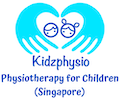Cerebral Palsy
Has your child's doctor just informed you that your child likely has cerebral palsy? Read on to find out more about cerebral palsy.
What is Cerebral Palsy?
Cerebral palsy (CP for short) is a disorder of movement and posture caused by abnormal development of the brain or damage to the developing brain. The brain damage that leads to CP can happen before birth, during birth, or during the early years of a child’s life. This affects a child’s ability to control his or her muscles and to maintain balance and posture. CP is the most common motor disability in childhood. Many children with CP also have related conditions such as seizures, heart issues, problems with speech and / or cognition.
Risk Factors that Increase the Chances of a Child Having Cerebral Palsy:
- Infections during pregnancy ― Maternal infections like viral / bacterial infections during pregnancy can lead to increases in inflammatory cytokines that circulate in the brain and blood of the fetus, and can lead to brain damage.
- Birth complications ― Problems with the umbilical cord during birth can disrupt oxygen supply to the baby.
- Premature birth ― Children who were born before the 37th week of pregnancy.
- Multiple births ― Twins, triplets, and other multiple births have a higher risk for CP.
- Low birthweight ― Children who weigh less than 2,500 grams at birth.
- Jaundice ― This is the yellow color seen in the skin of many newborns. It happens when a chemical called bilirubin builds up in the baby’s blood. When severe jaundice goes untreated for too long, it can cause a condition called kernicterus, which can cause CP and other conditions.
- After the baby is born, infections (such as meningitis) or injuries to the brain (such as Shaken Baby Syndrome) or problems with blood flow to the brain may lead to CP.
Types of Cerebral Palsy:
1. Spastic Cerebral Palsy
Spastic CP is the most common type of CP. It affects about 80% of children with CP. Children with spastic CP have increased muscle tone (stiff muscles). There are different types of spastic CP depending on which parts of the body are affected:
- Spastic diplegia ― This is the most common type of spastic CP. Children with spastic CP have muscle stiffness mainly in the legs, with the arms minimally affected. They tend to walk on their toes, and may scissor their legs (criss-cross their legs).
- Spastic hemiplegia ― This type of spastic CP affects only one side of a person’s body. Children with spastic hemiplegia tend to keep the hand fisted on the affected side, and have difficulty with using that hand.
- Spastic quadriplegia ― This is the most severe form of spastic CP and affects all four limbs and the trunk. Children with spastic quadriplegia usually cannot walk and have other developmental disabilities such as problems with speech or cognition.
2. Dyskinetic Cerebral Palsy
Children with dyskinetic CP have problems controlling the movement of all their limbs. The movements can be slow and writhing or fast and jerky. Children with dyskinetic CP have muscle tone that can change throughout the day.
3. Ataxic Cerebral Palsy
Children with ataxic CP have problems with balance and coordination, and are unsteady when they walk. They might have a hard time with movements that need a lot of control.
Diagnosing Cerebral Palsy
CP is usually diagnosed before the child is 2 years old. If a child’s symptoms are mild, the diagnosis may not be made until the child is older. Every child born in Singapore receives a Health Booklet that has a quick screen for a child's developmental milestones. It is important that parents do not miss these developmental screenings, as they provide the earliest signs of developmental delays and that a developmental evaluation may need to be done.
A developmental evaluation helps to evaluate movement or motor delays that affect a child. The paediatrician will look closely at the child’s motor skills, muscle tone, reflexes, and posture, and take a careful medical history from the parents. This is so that the paediatrician can find related conditions such as seizures, heart issues, problems with speech and / or cognition.
Besides the developmental evaluation, additional tests that the paediatrician may suggest to look for a cause of CP include brain imaging tests (CT scan or MRI), EEG (to determine seizures), genetic testing, and/or metabolic testing.
How severe is my child’s cerebral palsy?
We classify the severity of a child’s cerebral palsy by using the GMFCS (Gross Motor Function Classification System). The GMFCS describes the gross motor function of a child with cerebral palsy from below 2 years old to 18 years old.
The severity is classified from level 1 (least severe) to level 5 (most severe).
The GMFCS has been shown to be stable from 5 years old and above. This means that after 5 years old, your child is likely to remain in the classification level that he/she is in. Below 5 years old, the classification level may change depending on the intervention given, hence highlighting the importance of early intervention.
Severity of a child's cerebral palsy based on age
Classification levels using GMFCS| For kids less than 2 years old | |
| GMFCS level 1 | Get in and out of sitting Sit on floor with hands free to manipulate objects Crawl on all fours Pull to stand and cruise along furniture Walk independently by 18 – 24 months |
| GMFCS level 2 | Sit on floor but may use hands for support Crawl on tummy or on all fours May pull to stand and cruise along furniture |
| GMFCS level 3 | Sit on floor with low back supported Able to roll and crawl on tummy |
| GMFCS level 4 | Sit on floor with trunk support, able to control head upright Able to roll from tummy to back, may roll from back to tummy |
| GMFCS level 5 | Limited voluntary movements Unable to control head and trunk when on tummy or held in sitting Requires assistance to roll |
| For kids between 2 and 4 years old | |
| GMFCS level 1 | Get in and out of sitting and standing Prefer to walk |
| GMFCS level 2 | Get in and out of sitting Able to sit on floor, difficulty with sitting balance when both hands are used to manipulate objects Pull to stand Crawl on all fours Cruise along furniture or walk with handheld mobility equipment |
| GMFCS level 3 | Tend to W-sit to maintain sitting balance, may require assistance to get into sitting posture Prefer to crawl. Crawl on tummy or on all fours without reciprocal leg movement May pull to stand and cruise short distances May walk short distances indoors using a walker with assistance for steering and turning |
| GMFCS level 4 | Need assistance to get into sitting posture, and need to use hands for support Need adaptive equipment for sitting and standing Move around by rolling, crawling on stomach, or crawling on all fours without reciprocal leg movement |
| GMFCS level 5 | Poor voluntary control of movement Unable to maintain upright head and trunk postures Limited motor function in sitting and standing, even with the use of adaptive equipment and assistive technology No independent movement, pushed in a manual wheelchair in all settings. Some children can use a powered wheelchair with extensive adaptations |
| For kids between 4 and 6 years old | |
| GMFCS level 1 | Get in and out, and sit in a chair without hand support Get up from the floor and from chair to standing without the need for objects for support Walk indoors and outdoors Climb stairs Start to run and jump |
| GMFCS level 2 | Able to sit in a chair with both hands free to manipulate objects Get up from the floor to standing and from chair to standing but require a stable surface to push or pull up on with their arms Walk without the need for a handheld mobility equipment indoors and for short distances on level surfaces outdoors Climb stairs holding onto a handrail Unable to run or jump |
| GMFCS level 3 | Able to sit on a regular chair but may require pelvic or trunk support to maximise hand function Get in and out of chair using a stable surface to push on or pull up with their arms Walk with a handheld mobility equipment on level surfaces Climb stairs with assistance Pushed in a wheelchair when traveling for long distances or outdoors on uneven terrain |
| GMFCS level 4 | Able to sit on a chair but need adaptive seating for trunk control and to maximise hand function Get in and out of chair with assistance from an adult or a stable surface to push or pull up on with their arms May walk short distances with a walker and adult supervision but have difficulty turning and maintaining balance on uneven surfaces Pushed in a wheelchair in the community. May achieve self-mobility using a powered wheelchair |
| GMFCS level 5 | Poor voluntary control of movement Unable to maintain upright head and trunk postures Limited motor function in sitting and standing, even with the use of adaptive equipment and assistive technology No independent movement, pushed in a wheelchair in all settings. May achieve self-mobility using a powered wheelchair with extensive adaptations |
| For kids between 6 and 12 years old | |
| GMFCS level 1 | Walk at home, school, outdoors and in community Climb stairs without using handrail Able to run and jump, but speed, balance and coordination are reduced May participate in physical activities and sports depending on personal choices and environmental factors |
| GMFCS level 2 | Walk in most settings, may have difficulty with long distances and balancing on uneven ground, slopes, crowded or confined spaces or when carrying objects. May walk with physical assistance, use a handheld mobility equipment or a wheelchair over long distances Climb stairs holding handrail or with assistance if no handrail Minimal ability to run and jump May need adaptations to enable participation in physical activities and sports |
| GMFCS level 3 | When seated, children may require a seat belt for pelvic alignment and balance Sit-to-stand and floor-to-stand transfers require physical assistance of a person or support surface Walk indoors using a handheld mobility equipment Wheelchair when traveling long distances, may self-propel for shorter distances Climb stairs holding handrail with supervision or assistance May need adaptations to enable participation in physical activities and sports |
| GMFCS level 4 | Need adaptive seating for trunk and pelvic control and physical assistance for most transfers Mobility requires physical assistance in most settings. At home, children use floor mobility (roll, creep, or crawl), walk short distances with physical assistance, or use a powered wheelchair or a walker when placed in it. At school, outdoors, and in the community, children are pushed in a manual wheelchair or use a powered wheelchair Will need adaptations to enable participation in physical activities and sports |
| GMFCS level 5 | Transfers require complete physical assistance of an adult Difficulty maintaining head and trunk in upright positions Difficulty controlling leg and arm movements Assistive technology is used to improve head alignment, seating, standing, and and/or mobility but limitations are not fully compensated by equipment At home, children may move short distances on the floor or may be carried by an adult. Pushed in a manual wheelchair in all settings. Children may achieve self-mobility using a powered wheelchair with extensive adaptations for seating and control access Will need adaptations to enable participation in physical activities and sports |
| For kids between 12 and 18 years old | |
| GMFCS level 1 | Walk at home, school, outdoors, and in the community Able to walk up and down curbs without physical assistance Climb stairs without the use of a handrail Able to run and jump but speed, balance, and coordination are reduced May participate in physical activities and sports depending on personal choices and environmental factors |
| GMFCS level 2 | Walk in most settings. Environmental factors (such as uneven terrain, inclines, long distances, time demands, weather, and peer acceptability) and personal preference influence mobility choices. At school or work, may walk using a handheld mobility equipment for safety. Outdoors and in the community, may use a wheelchair when traveling long distances Climb stairs holding a handrail or with physical assistance if there is no handrail May need adaptations to enable participation in physical activities and sports |
| GMFCS level 3 | Walking using a handheld mobility equipment. More variability in methods of mobility depending on physical ability and environmental and personal factors. At school, may self-propel a manual wheelchair or use a powered wheelchair Outdoors and in the community, are pushed in a wheelchair or use a powered wheelchair When seated, may require a seat belt for pelvic alignment and balance Sit-to-stand and floor-to-stand transfers require physical assistance from a person or support surface May climb stairs holding onto a handrail with supervision or physical assistance May need adaptations to enable participation in physical activities and sports |
| GMFCS level 4 | Indoors, may walk short distances with physical assistance, use a wheelchair, or, when positioned, use a body support walker. Wheelchair use in most settings. Are physically capable of operating a powered wheelchair. When a powered wheelchair is not feasible or available, are pushed in a manual wheelchair Require adaptive seating for pelvic and trunk control Physical assistance from 1 or 2 persons is required for transfers. May support weight with their legs to assist with standing transfers Will need adaptations to enable participation in physical activities and sports |
| GMFCS level 5 | Pushed in a manual wheelchair in all settings. May achieve self-mobility using a powered wheelchair with extensive adaptations for seating and control access Unable to maintain head and trunk upright postures and control arm and leg movements. Assistive technology is used to improve head alignment, seating, standing, and mobility but limitations are not fully compensated by equipment Physical assistance from 1 or 2 persons or a mechanical lift is required for transfers Will need adaptations to enable participation in physical activities and sports |
Please note that besides the GMFCS (Gross Motor Function Classification System), there are other classification systems for children with cerebral palsy. Eg: the Manual Ability Classification System (MACS – classifies hand function), the Communication Function Classification System (CFCS), and the Eating and Drinking Ability Classification System (EDACS). These can be used together to give a more complete picture of the function of a child with cerebral palsy. I am unable to present the other classification systems due to lengthy nature of describing each classification system in detail.
How do I measure my child’s walking performance?
We classify a child’s walking performance by using the Functional Mobility Scale (FMS). The FMS describes the functional mobility of children with cerebral palsy from 4-18 years old.
The FMS describes:
- How your child moves around for short distances in the house. (5 metres)
- How your child moves in and between classes at school. (50 metres)
- How your child moves around in the community? (500 metres)
Moving around independently is important for activity and participation for any child. Many children with cerebral palsy walk slower with a higher energy cost compared to their typically developing peers. How they walk and the equipment they use may vary in different environments.
Classification of a child's walking performance based on distance and equipment used
Rating using the Functional Mobility Scale (FMS)| Rating | Description |
|---|---|
| 1 | Mainly uses wheelchair: May stand for transfers, may do some stepping when supported by a person or when using a walker/frame |
| 2 | Uses Kaye walker or frame independently |
| 3 | Uses crutches independently |
| 4 | Uses sticks (1 or 2) independently |
| 5 | Independent on level surface: Does not use walking aids or need help from a person. Requires a handrail for stairs |
| 6 | Independent when walking over all surfaces, including uneven ground, curbs, etc, and in a crowded environment |
FMS classification – Children are rated at 5m (eg: home), 50m (eg: school), and 500m (eg: shopping mall). A rating of 1, 2, 3, 4, 5, or 6 is given for each distance
Eg: If your child walks independently on all surfaces for 5m, uses a stick when walking 50m, and uses a walker when walking 500m, his/her FMS score will be recorded as FMS 6, 4, 2.
The FMS classification may change after medical / surgical treatment, and is a useful classification to monitor your child’s progress.
Treatment for Cerebral Palsy
There is no cure for CP, but early intervention can help your child achieve his fullest potential in his physical abilities.
Depending on your child's needs, different health professionals will be involved in the early intervention for your child. This may include the paediatrician, a paediatric physiotherapist, a paediatric occupational therapist, a paediatric speech therapist, a dietitian and the various medical specialists. Different treatment strategies will also be used.
Physiotherapy will include strengthening exercises and functional / developmental activities. Equipment such as braces, standers, walkers, wheelchairs, sticks, special shoes etc may be used in conjunction with physiotherapy exercises. Some children with cerebral palsy may also require certain medication and/or surgery.
Functional Electrical Stimulation (Neuromuscular estim) has been used with good effect to strengthen weak muscles and to facilitate functional movements and activities.
Effectiveness of Electrical Stimulation on scoliosis in children with severe cerebral palsy who are unable to do trunk strengthening exercises or undergo surgery for their scoliosis.
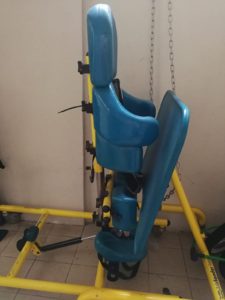
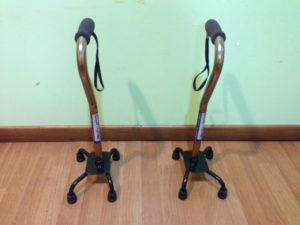
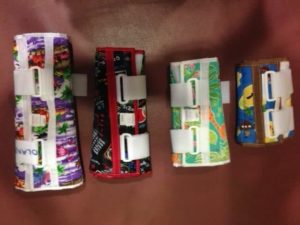
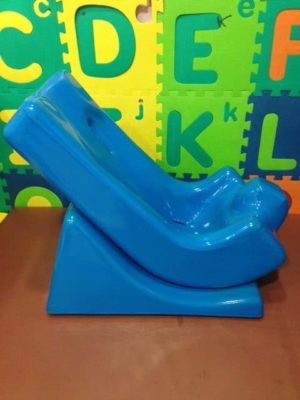
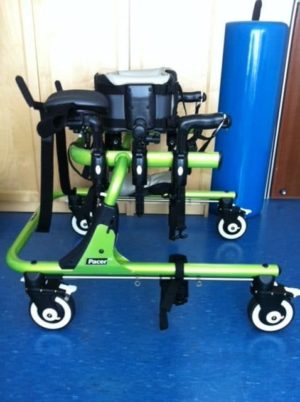

These are some of the equipment that may be used for your child with cerebral palsy.
Children's picture book of cerebral palsy (for children 7 years old and above).
If you are concerned that your child is not meeting his developmental milestones, and would like to start early intervention with a paediatric physiotherapist, please feel free to reach out to us for a consultation.
Let's get in touch
